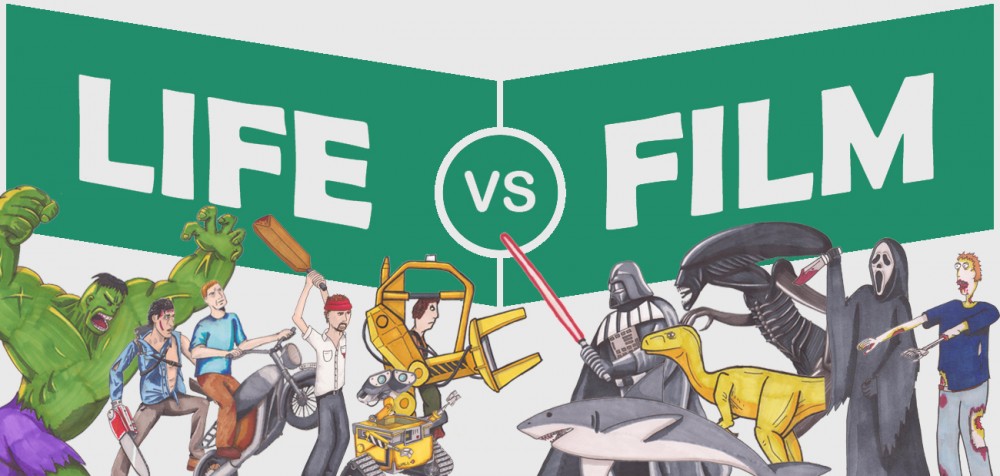
So, you’ve created a new way to make films; filling a large indoor space (dubbed The Volume) with cameras, covering your actors’ bodies with hundreds of motion capturing dots, films a scene then changing the actors to aliens and the warehouse to a jungle afterward on a computer, but you can’t think of a decent story to set it round. So what do you do? If you’re James Cameron, director of such cinematic milestones as
Terminator 1 & 2,
Aliens and
Titanic, then you steal. From everything. There isn’t an original moment in
Avatar, with
Platoon,
Star Wars,
Lord of the Rings,
Halo, Cameron’s own
Aliens and, most notably,
Dances with Wolves all receiving enough ‘loving homage’ to keep copyright lawyers in business for years to come. In the hands of a lesser director, or without the shiny new technology and 3D CGI gimmickry available this film would have been lost amid the also-ran film flotilla of 2009, but effects overcame plotting to elevate the film above its rightful place.
Sam Worthington plays Jake Sully, a US marine (with Worthington’s trademark unshakeable Australian accent) paralysed from the waist down, who volunteers to take the place of his recently deceased scientist brother in a mission to infiltrate the alien race of the Na’vi, 9ft tall lanky blue cat people with 4ft long rope-like tails and long black ponytails with USBs on the end. Jake is able to control a scientifically grown ‘avatar’ that responds to his body when wired up in a big plastic pod.
The maguffin of the plot is that the Na’vi live in a giant tree, under which is a vast source of a precious fuel known as unobtainium. You get the feeling they were supposed to rename that at some point but forgot, or Cameron came up with it and no-one had the guts to tell him it sounded stupid. Stephen Lang’s scarred Colonel Quaritch and Giovanni Ribisi’s corporate suit Parker want Jake to get the aliens to move, whilst Sigourney Weaver’s scientist and fellow avatar occupier Dr. Grace Augustine wants to learn more about the Na’vi way of life. When Jake is accepted into the alien tribe, he is torn between these two warring factions, as well as his own developing feelings for tribe member Neytiri (Zoe Saldana), and a simpler way of life that greatly appeals to him.

Breaking us into the sci-fi world gently, first showing us men, soldiers, scientists, then the avatars floating in their booths, 3D holograms and a few active avatars, we are then transplanted to the fully realised, completely created yet seamless and immersive fantasy world of Na’vi home planet Pandora, with vibrant, unusually active foliage and a wide variety of lifeforms perhaps a little too familiar to be believable as entirely alien. With 6-limbed bat-lemurs, giant hammerhead rhinos, vicious panther/dilophosaurus, wild oil-black dogs, helicopter lizards and of course giant freaking dragons, it’s not just the Earth film back catalogue from which Cameron has borrowed.
There was uproar when Saldana’s Neytiri wasn’t considered for an Oscar due to it being hidden behind a computer generated mask (yet Al Pacino was nominated for his latex-obscured turn in Dick Tracy, and John Hurt won for his in the Elephant Man), but there is no doubt she should have been considered for her fiery, animalistic turn as the fierce warrioress, her initial aggression towards Jake’s ‘dreamwalker’ gradually melting to pride, friendship and affection, ultimately leading to some freaky blue alien sex that was traumatising and completely unnecessary. As ever Worthington puts in a blank canvas of a role, although this is arguably what is required of his jarhead moron, leaving him ready to be imprinted upon by Quaritch, Augustine of Neytiri.

For those concerned with a new spin on
Titanic’s across the tracks romance dominating the film fear not, as there is more than just romance breaking through language barriers and a less-than-subtle environmental message. The final half hour battle between the soldiers and the Na’vi, including aerial assaults and a reversal of Aliens’ giant mech battle, rivals any war film, and is worth the entry fee alone. Be sure to stop watching before Leona Lewis’ ear-gougingly awful credits song though.
Choose film 6/10







